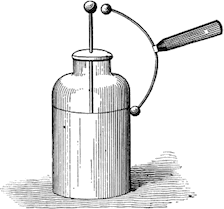The “Electricians”
“The History of Electricity is a field full of pleasing objects, according to all the genuine and universal principles of taste, deduced from a knowledge of human nature. Scenes like these, in which we see a gradual rise and progress in things, always exhibit a pleasing spectacle to the human mind.” ~ Jos. Priestley
The Natural Philosopher incorporates a large collection of electrical apparatus including Electrostatic Generators, Leyden jars, Voltaic Piles, and electrical tricks and toys akin to those used by Benjamin Franklin and other 18th century “electricians”. The shocking escapades of the Electricians began as entertaining recreation where “doses of electrical fluid” where shared with the audiences, but formed the basis of the Electrical Age to come. These narratives have several themes and characterizations.
“Electrical Fire”
Demonstrations in the curious properties of static electricity fascinated Dr Franklin and many others who saw electricians in public lectures and salons in Europe and America. Mr. Howarth portrays several such showmen who were contemporaries of Franklin.
- Ebenezer Kinnersley was an itinerant lecturer from Philadelphia and personal friend of Franklin. His demonstrations mimic those done by Franklin as he laid out the first laws of electricity using Leyden Jars, Electrostatic Generators, and Lightning Rods
- Samuel Domjen was an charismatic lecturer from Transylvania who was inspired to travel the world sharing the Wonders of Electrical Fire. He conducted audacious spectacles with electricity in “enlightened” salons in Europe where ladies of the court were electrified with (literally) hair-raising results.
The Galvanist
The Galvanists believed in Luigi Galvani’s theory of “animal electricity” and felt that electrical currents were the vehicle of life. They studied electrical eels, and used electricity to stimulate living creature (both alive and dead). The macabre experiments inspired medical science and science fiction.
The Science of Frankenstein
Mary Shelley’s monster was brought to life by a man of science, Victor Frankenstein. Shelley’s chilling story echoes the work of galvanists like Giovani Aldini and Andrew Ure, who attempted to reanimate the dead. This narrative also recounts the ghoulish work of the “Resurrection Men” who procured the cadavers for the anatomy theaters… by means most unsavory.
Electrical Quackery
Dr James Graham was one of many quack physicians who thought that electricity was a cure for any and all ailments. Graham’s Electrical Temple of Health in London offered treatments for everything from baldness to matters of a more romantic nature. The Electrical Celestial Bed featured electrified posts and musical accompaniments by Franklin’s glass harmonica, and the “electrical kiss” kindled intimate sparks. The narrative includes the dubious work of other quack scientists such as Franz Anton Mesmer and Elisha Perkins.




